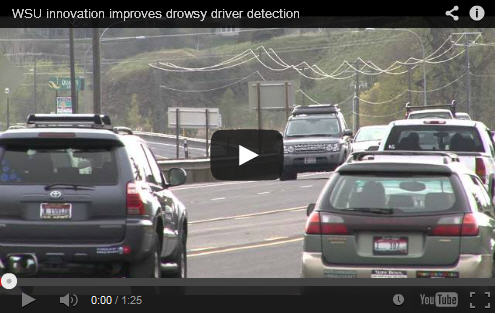WSU innovation improves drowsy driver detection

Their recently patented technology is based on steering wheel movements—which are more variable in drowsy drivers—and offers an affordable and more reliable alternative to currently available video-based driver drowsiness detection systems.
“Video-based systems that use cameras to detect when a car is drifting out of its lane are cumbersome and expensive,” said Hans Van Dongen, research professor at the WSU Sleep and Performance Research Center. “They don’t work well on snow-covered or curvy roads, in darkness or when lane markers are faded or missing.
“Our invention provides an inexpensive and user-friendly technology that overcomes these limitations and can help catch fatigue earlier, well before accidents are likely to happen,” said Van Dongen, who developed the technology with postdoctoral research fellow Pia Forsman.
The science behind the invention was published in the journal Accident Analysis & Prevention. Researchers analyzed data from two laboratory experiments conducted at WSU Spokane.
Twenty-nine participants were on a simulated 10-day night shift schedule that caused moderate levels of fatigue, as assessed by their performance on a widely used alertness test known as the psychomotor vigilance task (PVT). During each night shift, participants spent four 30-minute sessions on a high-fidelity driving simulator, which captured data for 87 different metrics related to speed, acceleration, steering, lane position and other factors.
Data analysis indicated that the two factors that best predicted fatigue were variability in steering wheel movements and variability in lane position.
Researchers then showed that data on steering wheel variability can be used to predict variability in lane position early on, making it possible to detect driver drowsiness before the car drifts out of its lane.
“We wanted to find out whether there may be a better technique for measuring driver drowsiness before fatigue levels are critical and a crash is imminent,” Van Dongen said. “Our invention provides a solid basis for the development of an early detection system for moderate driver drowsiness. It could also be combined with existing systems to extend their functionality in detecting severe driver drowsiness.”
The solution uses inexpensive, easy-to-install parts—including a sensor that measures the position of the steering wheel—and could be included as part of a factory installation or as an aftermarket accessory.
A patent for this method of measuring driver drowsiness has been assigned to WSU under patent number 8676444, with Van Dongen and Forsman as the inventors.
The paper describing their work was published in Vol. 50 of Accident Analysis & Prevention with Forsman—now with the University of Helsinki in Finland—as the lead author. Coauthors include Van Dongen; WSU researchers Bryan Vila and Robert Short; and Christopher Mott of Pulsar Informatics, a private firm that develops behavioral alertness technology.
Contacts:
Hans Van Dongen, WSU Spokane Sleep and Performance Research Center, 509-358-7755, hvd@wsu.edu
Judith Van Dongen, WSU Spokane/WSU News, 509-358-7524, jcvd@wsu.edu
Media Contact
All latest news from the category: Automotive Engineering
Automotive Engineering highlights issues related to automobile manufacturing – including vehicle parts and accessories – and the environmental impact and safety of automotive products, production facilities and manufacturing processes.
innovations-report offers stimulating reports and articles on a variety of topics ranging from automobile fuel cells, hybrid technologies, energy saving vehicles and carbon particle filters to engine and brake technologies, driving safety and assistance systems.
Newest articles

You are What You Eat—Stanford Study Links Fiber to Anti-Cancer Gene Modulation
The Fiber Gap: A Growing Concern in American Diets Fiber is well known to be an important part of a healthy diet, yet less than 10% of Americans eat the minimum recommended…

Trust Your Gut—RNA-Protein Discovery for Better Immunity
HIRI researchers uncover control mechanisms of polysaccharide utilization in Bacteroides thetaiotaomicron. Researchers at the Helmholtz Institute for RNA-based Infection Research (HIRI) and the Julius-Maximilians-Universität (JMU) in Würzburg have identified a…

ASXL1 Mutation: The Hidden Trigger Behind Blood Cancers and Inflammation
Scientists show how a mutated gene harms red and white blood cells. LA JOLLA, CA—Scientists at La Jolla Institute for Immunology (LJI) have discovered how a mutated gene kicks off…



